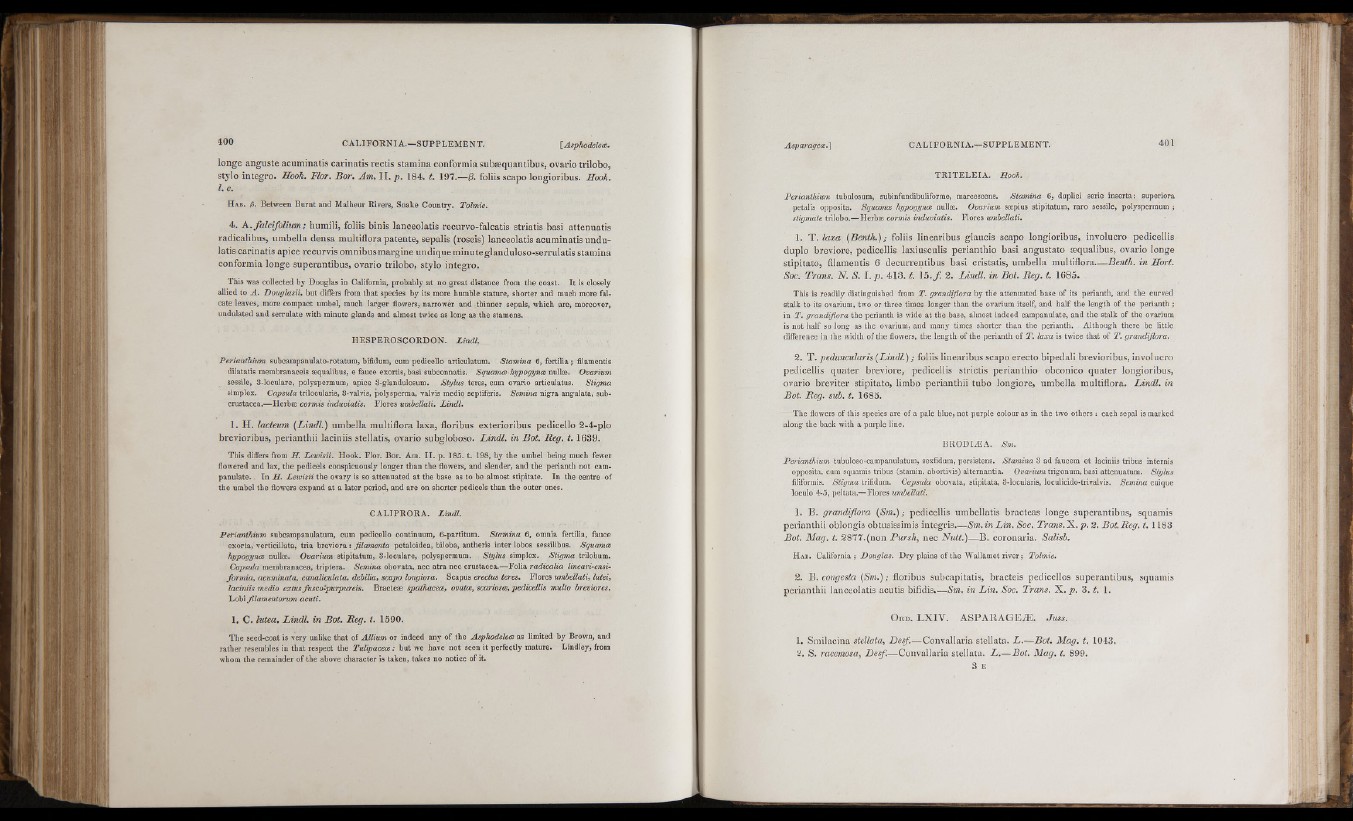
longe anguste acuminatis carinatis rectis stamina conformia subæquantibus, ovario trilobo,
stylo integro. Hook. Flor. B or. A m . l l . p . 184. t. 197.—(3, foliis scapo longioribus. Hook.
I. c.
H a b . fi. Between Burnt and Malheur Rivers, Snake Country. Tolmie.
4. A .fa lc ifo lium s humili, foliis binis lanceolatis recurvo-falcatis striatis basi a ttenuatis
radicalibus, umbella densa multiflora p aten te, sepalis (roseis) lanceolatis acuminatis u n d u latis
carinatis apice recurvis omnibus m argine u ndiq u em in u teg lan d u lo so -serru latis stamina
conformia longe superantibus, ovario trilobo, stylo integro.
This was collected by Douglas in California, probably at no great distance from the coast. It is closely
allied to A . Douglasii, but differs from that species by its more humble stature, shorter and much more falcate
leaves, more compact umbel, much larger flowers, narrower and thinner sepals, which are, moreover,
undulated and serrulate with minute glands and almost twice as long as the stamens.
H ES PERO SCORDON. Lindl.
Perianthium subcampanulato-rotatum, bifidum, cum pedicello articulatum. Stamina 6, fertilia; filamentis
dilatatis membranaceis æqualibus, e fauce exortis, basi subconnatis. Squamoe hypogyna nullæ. Ovarium
sessile, 3-loculare, polyspermum, apice 3-glandulosum. Stylus teres, cum ovario articulatus. Stigma
simplex. Capsula trilocularis, 3-valvis, polysperma, valvis medio septiferis. Semina nigra angulata, sub-
crustacea.—Herbæ cormis induviatis. Flores umbellati. Lindl.
1. H . lacteum {Lindi.) umbella multiflora laxa, floribus exterioribus pedicello 2-4-plo
brevioribus, p e rian th ii laciniis stellatis, ovario subgloboso. L in d l. in Bot. Reg. t. 1639.
This differs from H. Lcioisii. Hook. Flor. Bor. Am. I I . p. 185. t. 198, by the umbel being much fewer
flowered and lax, the pedicels conspicuously longer than the flowers, and slender, and the perianth not campanulate.
In H. Lewisii the ovary is so attenuated at the base as to be almost stipitate. In the centre of
the umbel the flowers expand at a later period, and are on shorter pedicels than the outer ones.
CALIPRORA. Lindl.
Perianthium subcampanulatum, cum pedicello continuum, 6-partitum. Stamina 6, omnia fertilia, fauce
exorta, verticillata, tria breviora : filamenta petaloidea, biloba, antheris inter lobos sessilibus. Squamoe
hypogynæ nullæ. Ovarium stipitatum, 3-locuIare, polyspermum. Stylus simplex. Stigma trilobum.
Capsula membranacea, triptera. Semina obovata, nec atra nec Crustacea.—Folia radicalia lineari-ensi-
formio, acuminata, canaliculata, debilia, scapo longiora. Scapus erectus teres. Flores umbellati, lutei,
laciniis medio extus fusco-purpureis. Bracteæ spaihaceæ, ovatæ, scariosoe, pedicellis multo breviores.
Lobi filamentorum acuti.
I. C. lutea. Lin d l. in Bot. Reg. t. 1590.
The seed-coat is very unlike that of Allium or indeed any of the Asphodeleæ as limited by Brown, and
rather resembles in that respect the Tulipaceoe : but we have not seen it perfectly mature. Lindley, from
whom the remainder of the above character is taken, takes no notice of it.
TR IT E L E IA . Hooh.
Perianthium tubulosum, subinfundibuliforrae, marcescens. Stamina 6, duplici serie inserta: superiora
petalis opposita. Squamæ hypogynæ nullæ. Ovarium sæpius stipitatum, raro sessile, polyspermum ;
stigmate trilobo.—Herbæ cormis induviatis. Flores umbellati.
1. T . la x a {Benth.); foliis linearibus glaucis scapo longioribus, involucro pedicellis
duplo breviore, pedicellis laxiusculis perianthio basi angustato æqualibus, ovario longe
stipitato, filamentis 6 d ecurrentibus basi cristatis, umbella multiflora— Benth. in Hort.
Soc. Trans. N . S. l . p . 413. t. 1 5 . / 2. L in d l. in Bot. R eg . t. 1685.
This is readily distinguished from T. grandiflora by the attenuated base of its perianth, and the curved
stalk to its ovarium, two or three times longer than tbe ovarium itself, and half the length of the perianth ;
in T. grandiflora the perianth is wide at the base, almost indeed campanulate, and the stalk of the ovarium
is not half so long as the ovarium, and many times shorter than the perianth. Although there be little
difference in the width of the flowers, the length of the perianth of T . laxa is twice that of T , grandiflora.
2. T . pedunculatis {Lindi.) ; foliis linearibus scapo erecto bipedali brevioribus, involucro
pedicellis q u a te r breviore, pedicellis strictis perianthio obconico q u a te r longioribus,
ovario breviter stipitato, limbo p e rian th ii tubo longiore, umbella multiflora. L in d l. in
Bot. Reg. sub. t. 1685.
The flowers of this species are of a pale blue, not purple colour as in the two others ; each sepal is marked
along the back with a purple line.
B RODIÆA. Sm.
Perianthium tubuloso-campanulatum, scsfidum, persistens. Stamina 3 ad faucem et laciniis tribus internis
opposita, cum squamis tribus (stamin. abortivis) alternantia. Ovarium trigonum, basi attenuatum. Stylus
filiformis. Stigma trifidum. Capsula obovata, stipitata, 3-locularis, loculicido-trivalvis. Semina cuique
loculo 4-5, peltata.—Flores umbellati.
1. B. grandiflora {Sm.) ; pedicellis umbellatis bracteas longe superantibus, squamis
p e rianthii oblongis obtusissimis in teg ris.—Sm .in L in . Soc. T ra n s .N ..p . 2. Bot.Reg. t. 1183
Bot. Mag. t 2 8 7 7 .(non Pursh, nec N u tt.)— B. coronaria. Salisb.
H a b . California; Douglas. Dry plains of the Wallamet river; Tolmie.
2. B. congesta {Sm.); floribus subcapitatis, bracteis pedicellos superantibus, squamis
pe rian th ii lanceolatis acutis bifidis.—Sm. in L in . Soc. Trans. N . p . 3. t. 1.
O r d . L X IV . A S PA R A G EÆ . Juss.
1. Smilacina stellata, Desf.— Convallaria stellata. L .—Bot. Mag. t. 1043.
2. S. racemosa, Desf.— Convallaria stellata. L .—Bot. Mag. t. 899.
3 E